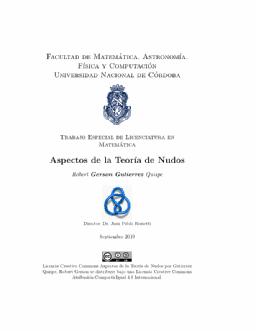| dc.contributor.advisor | Rossetti, Juan Pablo | |
| dc.contributor.author | Gutierrez Quispe, Robert Gerson | |
| dc.date.accessioned | 2020-02-17T12:57:16Z | |
| dc.date.available | 2020-02-17T12:57:16Z | |
| dc.date.issued | 2019-09 | |
| dc.identifier.uri | http://hdl.handle.net/11086/14649 | |
| dc.description | Tesis (Lic. en Matemática)--Universidad Nacional de Córdoba, Facultad de Matemática, Astronomía, Física y Computación, 2019. | es |
| dc.description.abstract | Los nudos, tal cual aparecen en nuestra vida cotidiana, son un objeto de estudio en la Matemática. La Teoría de Nudos es la rama de la Matemática que se encarga de su estudio. Un problema central es el de poder decir si dos nudos dados son equivalentes o no. Los matemáticos, en la búsqueda de responder esta pregunta, entre otras, han desarrollado diversas técnicas y herramientas en esta área de estudio. En este trabajo se hace un recorrido en el estudio de la Teoría de Nudos, comenzando con las definiciones más elementales, hasta llegar a estudiar herramientas sofisticadas como el polinomio de Alexander, el grupo de un nudo y las matrices de Seifert, entre otros. En los dos últimos capítulos se investigan los dos temas siguientes: nudos virtuales y presentaciones de Wirtinger. En este último se hace un aporte, dando una nueva familia infinita de presentaciones de Wirtinger no geométricas. | es |
| dc.description.abstract | The knots we usually see in our lifes are studied in mathematics in the branch called Knot Theory. A main problem is to decide whether two knots are equivalent or not. Many tools and techniques have been developed by mathematicians in order to answer this and other related questions.
In this work, we study Knot Theory from the beginning, with definitions and elementary notions, until some sophisticated concepts and tools like the Alexander polynomial, the knot group and Seifert matrices, among others. In the last two chapters, we work on the following two particular subjects: virtual knots and Wirtinger presentations. In this last one, we made a small contribution by presenting a new infinite family of Wirtinger presentations which are not geometric. | en |
| dc.language.iso | spa | es |
| dc.rights | Atribución-CompartirIgual 4.0 Internacional | * |
| dc.rights.uri | http://creativecommons.org/licenses/by-sa/4.0/ | * |
| dc.subject | Teoría de nudos | es |
| dc.subject | Polinomio de Alexander | es |
| dc.subject | Presentación de Wirtinger | es |
| dc.subject | Variedad de Seifert | es |
| dc.subject | Nudos virtuales | es |
| dc.subject | Knots and links in $S^3$ | en |
| dc.subject | Invariants of knots and 3-manifolds | en |
| dc.subject | Knot theory | en |
| dc.subject | Seifert manifold | en |
| dc.subject | Alexander polynomial | en |
| dc.subject | Wirtinger presentation | en |
| dc.title | Aspectos de la teoría de nudos | es |
| dc.type | bachelorThesis | es |
| dc.description.version | info:eu-repo/semantics/publishedVersion | |
| dc.description.fil | Fil: Gutierrez Quispe. Robert Gerson. Universidad Nacional de Córdoba. Facultad de Matemática, Astronomía, Física y Computación; Argentina. | es |





